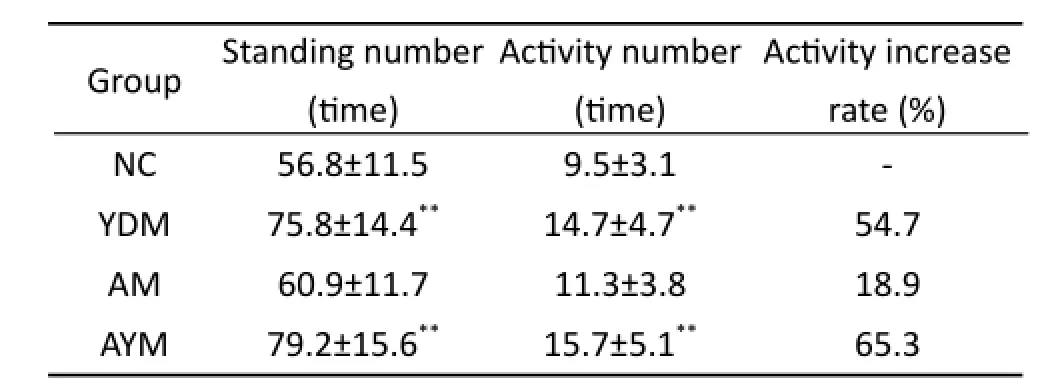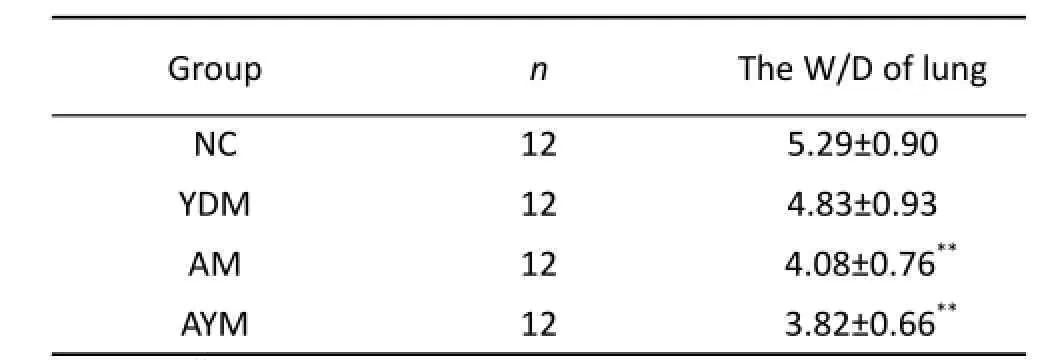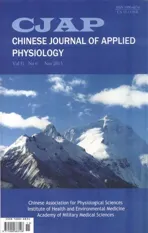Establishment and evaluation of a mouse model of bronchial asthma with Yin deficiency syndrome
2015-05-22ZhiwangWANGRongkeLIYuanRENXuefengLIUXiaoliCHENGHaiyanTUO
Zhi-wang WANG, Rong-ke LI, Yuan REN, Xue-feng LIU, Xiao-li CHENG, Hai-yan TUO
Gansu University of Traditional Chinese Medicine, Lanzhou 730000, China
Establishment and evaluation of a mouse model of bronchial asthma with Yin deficiency syndrome
Zhi-wang WANG, Rong-ke LI, Yuan REN, Xue-feng LIU, Xiao-li CHENG, Hai-yan TUO
Gansu University of Traditional Chinese Medicine, Lanzhou 730000, China
doi 10.13459/j.cnki.cjap.2015.06.011
Objective: To establish and evaluate a mouse model of bronchial asthma with Yin def i ciency syndrome. Methods: The mouse model of bronchial asthma with Yin def i ciency syndrome was established by the treatment with injecng ovalbumin (OVA) twomes to sensize, inhaling OVA 14mes to smulate, and using thyroxin through lavage during late smulaon. This model was evaluated through body weight, asthmac behaviors, respiratory funcon, autonomous acvity, lung pathology, and pulmonary fl uid clearance. Results: OVA combined with thyroxin was an appropriate method to induce the mouse model with increased food and water intake, autonomous activity, asthmatic behaviors score, and respiratory rate, decreased body weight,dal volume, and wet/dry rao of lung, and changed with pathology of lungssue. The changes of the above menoned parameters indicated that the model was the bronchial asthma with Yin def i ciency syndrome. Conclusion: The OVA combined with thyroxin is a good paern to establish a mouse model of bronchial asthma with Yin def i ciency syndrome successfully, which can highly simulate the clinical symptoms of this disease.
bronchial asthma; Yin def i ciency syndrome; animal model; mouse
Introduction
Materials and Methods
Animals and experimental grouping
A total of 48 female BALB/c mice[5-6] (provid-ed by Lanzhou Veterinary Research Institute, Chinese Academy of Agricultural Sciences, No. 62000600000083) weighing (18±2)g were used in this study. The mice adapted to experimental environment for 7 days in SPF grade laboratory in Gansu University of Traditional Chinese Medicine (No. 00000116). The room humidity and temperature were maintained at 50%~70% and 20°C-25°C with 12 h light and dark cycle. According to the body weight, the mice were randomly divided into normal control group (NC group), Yin def i ciency model group (YDM group), asthma model group(AM group), and asthma with Yin def i ciency syndrome model group (AYM group) with 12 mice in each group.
Experiment method
On the fi rst and eighth day (a total of 2 times), AM group and AYM group mice were intraperitoneally and hypodermically injected 0.2 ml sensitization solution (including OVA 100 μg and aluminum hydroxide 3 mg) each time, and then inhaled atomizing 1% OVA 20 min with 2 ml/min every two days from 15thday to 42thday.e mice of NC group and YDM group were handled with normal saline. From 29thday to 42thday, the mice of YDM group and AYM group were givenyroxin through lavage once daily, and the mice of NC group and AM group were done with 0.5% Xanthan gum [7].
Indexes and examination methods
Under monitoring the general situation such as body weight, food intake and water intake, the number of standing and activity during 5 minutes was recorded in the activity counter after adapting 3 minutes in 7:00-11:00 PM on the 41th day. On the 27th and 41st days, from inhaled 2% OVA 120 seconds with 2 ml/min, grabbing nose, tickling, asthma attack and other asthmatic behaviors were observed in 10 minutes. Specific scoring criteria: The mice do not grab nose or tickle recorded as 0 points, the number of grabbing noses or tickling recorded is 1-3 as 1 points, the number of grabbing noses or tickling recorded is 4-6 as 2 points, and the number of grabbing noses or tickling recorded is above 7 as 3 points; the mice without asthma symptoms record 0 points, the mice have mild asthma symptoms record 3 points, shortness of breath, respiratory frequency increased or anxiety and other symptoms of asthma record 6 points, severe respiratory problems such as respiration accompanied by rapid nod, abdominal breathing and other symptoms of asthma record 9 points[8].e mice were placed in the lung function instrument to measure lung function when the experiment was carried out to the 42th day. At the end of animal experiment, after anesthetized the mice by the intraperitoneal administration of 50 mg/ kg pentobarbital sodium solution and sacrificed, the lungs of mice were removed and cut two parts in fixed position. The first part of lung tissue was observed under microscope after formalin fixation, biopsy and HE staining and the shedding degree of the bronchial epithelial cells was analyzed. The second part of lung tissue was weighed wet weight. After full dried to constant weight the dry weight was weighed and wet dry weight ratio (W/D) was calculated.
Statistical analysis
The data of quantity response were expressed as “mean±standard deviation” (mean±SD), and analyzed the statistical signif i cance with the one-way ANOVA or with Ridit if the data were the grade data.e data of qualitative response were analyzed with Chi square test.
Results
Effects of asthma with Yin deficiency syndrome on food and water intake and body weight of mice
In the process of experiment, the mice of NC group had no obvious change, particularly in the food and water intake, and the body weight grew normally. When the experiment was over, compared with NC group, the food and water intake of YDM group and AYM group significantly increased, but the body weight gained slowly (P<0.05, 0.01) although as the experiment begin the body weight was no signif i cant dif f erences because of stratif i ed and random grouped (Tab.1). The water-intake increase of YDM group, AM group and AYM group hinted that Yin def i ciency and asthma could stimulate mice drinking water.
Effects of asthma with Yin deficiency syndrome on autonomous activity of mice
Effects of asthma with Yin deficiency syndrome on asthmatic behaviors of mice
Phlegm, cough and asthma are clinical common symptoms of asthma, and the mice have symptoms of grabbing nose and asthma attack, and also have allergic symptoms, such as tickling when the mice were replicated the model of allergic asthma. In the middle and later stage of the experiment, it is found that the number of asthmatic animals and the complex score of AM group and AYM group were markedly increased compared with NC group (P<0.05, 0.01) when inhaled atomizing high-concentration OVA (2%). But the mice of YDM group had no above phenomena (Tab.3).
Effects of asthma with Yin deficiency syndrome on respiratory function of mice
Effects of asthma with Yin deficiency syndrome on pulmonary fl uid clearance of mice
Effects of asthma with Yin deficiency syndrome on lung tissue histological changes of mice
It is not very obvious that these are lung tissue histological changes of NC group and YDM group, however, the pathological reactions of AM group and AYM group are very clear. For example, the bronchial epithelial cells (BEC) swell and shed, the basement membrane thickens, and the bronchial wall congests and it’s structure becomes fuzzy (Fig.1). After semi-quantitative analysis, the BEC shed of AM group and AYM group is obviously serious compared with that of NC group (P<0.01). On the other hand, differences in pathology between YDM group and NC group and between AYM group and AM group are not very clear. This shows that Yin deficiency syndrome could not cause pathological changes of lung although the Yin def i ciency syndrome in asthma generally means Yin def i ciency syndrome of lung and/or kidney in the Traditional Chinese Medicine (Tab.6).
Discussion

Tab.1 Effects of asthma with Yin deficiency syndrome on food and water intake and body weight of mice (mean±SD,n=12).

Tab.2 Effects of asthma with Yin deficiency syndrome on autonomous activity of mice (mean±SD,n=12).

Tab.3 Effects of asthma with Yin deficiency syndrome on asthmatic behaviors of mice (mean±SD,n=12).

Tab.4 Effects of asthma with Yin deficiency syndrome on respiratory function of mice (mean±SD,n=12).

Tab.5 Effects of asthma with Yin deficiency syndrome on pulmonary fluid clearance of mice (mean±SD).

Fig. 1 Effects of asthma with Yin deficiency syndrome on lung tissue histological changes of mice (HE staining; ×20). A: Normal control group (NC group); B: Yin deficiency model group (YDM group); C: Asthma model group(AM group); D: Asthma with Yin deficiency syndrome model group (AYM group).
In the evaluation of the disease-syndrome model in the field of combination of Chinese traditional and Western medicine, the indexes of study are not only including disease that based on cognition of the whole process of the disease, but also including syndrome based on cognition of the disease at present stage, and also combining new results of modern research [12]. The metabolism of three nutrient and water is the basis of life activities, and def i ciency of yin means def i ciency of semen, blood, and fluid thick, and relative hyperfunction of Yang. In this study, the evaluating indicators include food and water intake, body weight, autonomous activity, and pulmonary ff uid clearance.e results show that the food and water intake of the mouse model of bronchial asthma with Yin deficiency syndrome is markedly increased, but the body weight gains slowly. It is intended to hint clearly that the model’sbasic metabolic rate increased signif i cantly and there have been some typical signs of def i ciency of yin in the mouse.e increase on standing number and activity number and the decrease in the wet dry weight ratio of lung indicate that the mouse is in the state of Yin def i ciency and Yang excess, and the lung is in the state of def i ciency of semen, blood, and ff uid thick.

Tab. 6 Effects of asthma with Yin deficiency syndrome on shedding epithelial cell of bronchus in mice (mean±SD,n=12).
The evaluation of a animal model should be focused on pharmacological action although there are pharmacological action and mechanism. Phlegm, cough and asthma are clinical common symptoms of asthma. although the cough sound of the mouse is too small to perceive and the phlegm is difficult to quantify, the asthma has a typical symptom. The asthma can cause respiratory abnormalities such as shortness of breath, breathing accompanied by nodding, and abdominal breathing, and it can also cause hypoxia and neurological symptoms like restless, upright sitting, and rapid climbing bedding and so on.e asthma model copied by OVA belongs to allergic asthma model and the mouse will appear easy to quantify indicators like tickling and grabbing nose. So in this study, the grabbing nose, tickling, and asthmatic symptoms are selected as asthma behavior evaluation standard.e results show that the complex score of bronchial asthma with Yin deficiency syndrome in mice is significantly higher. The respiratory function and the lung tissue histology are the most direct indicators that give expression to function and structure of lung. In this experiment, the respiratory function of bronchial asthma with Yin def i ciency syndrome in mice is declining signif i cantly and the lung tissue histology shows pathological change, for example the shedding degree of bronchial epithelial cells gets very clear.
Conclusion
On the basis of copying asthma model with OVA, using Thyroid hormone the mouse model of bronchial asthma with Yin deficiency syndrome is successfully replicated. The above method is simple and the relevant indexes change signif i cantly. And it meets diagnosis of disease by Western Medicine and the characteristics understood by TCM Syndrome. This experiment provides the ideal animal model of asthma with Yin deficiency syndrome for study mechanism and anti-asthmatic drugs.
Acknowledgements
This work was supported by the National Natural Science Fund (the regional project, 81460668), the Natural Science Foundation of Gansu Province (1310RJZA086) and the open fund project of Key Laboratory of Pharmacology and Toxicology for Traditional Chinese Medicine of Gansu Province(ZDSYS-KJ-2013-008).
1. Chen XC, Wu HJ, Li JY. Correlation analysis between children asthma exacerbation and air pollution and meteorological factors in the Wenzhou city [J]. CJCHC JAN, 2015, 23(1): 11-14.
2. Yao RF, Jiang PH, Xu GX,et al.e signif i cance of allergen detection for eczema, allergic rhinitis and asthma patients [J]. Laboratory Medicine, 2015, 30(5): 457-460.
3. Zhao X, Lu HY, Sun YQ. 120 cases asthma Chinese medicine classification study [J]. J Nanjing Univ TCM, 2014, 30(1): 27-29.
4. Liang YL, Gao CX, LI QQ, et al. Study 703 college students' constitution applying of TCM body mass scale [J]. Lishizhen Med Mater Res, 2014, 25(1): 162-163.
5. Du J, Guo HW, Deng JG, Research status analysis of asthma mouse model [J]. Chin J Immunol, 2011, 27(1): 1209-1211.
6. Bosnjak B, Tilp C, Tomsic C,et al. Tiotropium bromide inhibits relapsing allergic asthma in BALB/c mice [J]. Pulm Pharmacol Ther, 2014, 27(1): 44-51.
7. He YW, Chai CZ, Kou JP,et al. Correlative study between the exterior signs of mice model induced byyroxine and hyperactivity of fi re due to Yin deficiency syndrome [J]. Lab Anim Sci, 2013, 30(2): 1-7.
8. Wang ZW, Sun SB, Wang YH,et al. Effect of VOA on anti-asthma and the expression of IL-4, IFN-γ in a rat asthmatic model [J]. Immunol J, 2013, 29(5): 391-394.
9. Wang P, Wang XJ. Study of kidney yin def i ciency animal model [J]. Inform TCM, 2013, 30(4): 123-125.
10. Ma ZF, Yi LM, Ran J,et al. Analysis on characteristics of mouse allergic asthma model [J]. J Southeast Univ (Med Sci Edi), 2014, 33(5): 650-655.
11. Zhang TZ, Fu Q, Chen T,et al. Anti-asthmatic effects of oxymatrine in a mouse model of allergic asthma through regulating CD40 signaling [J]. Chin J Nat Med, 2015, 13(5): 368-374.
12. Yuan FN, Chen, SQ, Li XB. Conception of consititution-disease-syndrone animal model [J]. CJTCMP, 2012, 27(7): 1735-1737.
Zhi-wang WANG, MD, Professor, Pharmacology Laboratory, Lanzhou 730000, China. Tel: 86-931-8765395; E-mail: wzw0933@126.com. Yuan REN, Tel: 86-931-8762653; E-mail: leyuan988@163.com
Received 2015-08-04; accepted 2015-10-16
杂志排行
中国应用生理学杂志的其它文章
- A mini review: Tau transgenic mouse models and olfactory dysfunction in Alzheimer’s Disease
- Ethical inspection about laboratory animals
- Better parameters of ventilation-CO2output relationship predict death in CHF patients
- Association between endothelial nitric oxide synthase (ENOS) G894T polymorphism and high altitude (HA) adaptation: a meta-analysis
- Flow cytometric analysis of circulating microvesicles derived from myocardial ischemic preconditioning and cardioprotection of ischemia/reperfusion injury in rats
- Synergisms of cardiovascular effects between iptakalim and amlodipine, hydrochlorothiazide or propranolol in anesthetized rats
